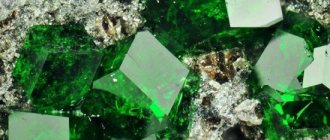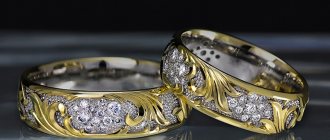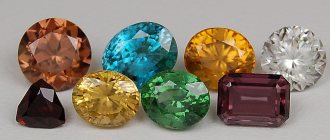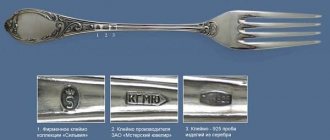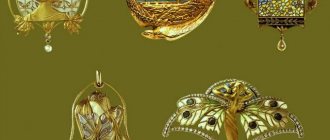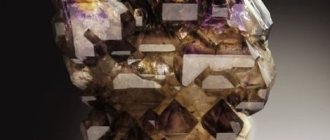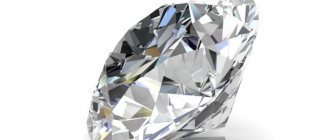What is Art Deco?
Leaf from the album Feuillets d'Art. 1919
Leaf from the album Les choses de Paul Poiret vues par Georges Lepape. 1911
Leaf from the album Modes et Manières d'Aujourd'hui. 1914
Art Deco, which means “decorative arts” in French, is the name of the artistic style that reigned in Europe and America after Art Nouveau, between the two world wars. Moreover, it reigned mainly in industrial design - fashion, jewelry, posters, facades, interiors, furniture. This happened while the “great art” of that era was experimenting with expressionism, abstractionism, constructivism and other -isms, which, of course, are brilliant, but not everyone will be able to see them constantly in their apartment. And Art Deco items are intended specifically for everyday life - very rich, luxurious and impressive, but still everyday.
Art Deco Jewelry
Art Deco (French art deco) is a style movement in art between World Wars I and II, which is characterized by a combination of monumental weighted forms with sophisticated decoration, a combination of elements of Art Nouveau, Cubism and Expressionism, and the use of expressive forms of technical design. Jewelers, always sensitive to the mood in society, quickly realized that their art could bring people joy and help them forget about the horrors of war. But to achieve this it was necessary to offer fundamentally new products. In search of new means of expression, they turned to clear geometric forms, with a clear construction of symmetrical compositions, in which beautifully cut precious stones played a dominant role. It combined simplicity and luxury, clarity of geometric designs and a bright play of sparkling stones. Among the most picturesque decorations, undoubtedly, was the “tassel brooch” that decorated the open collar of an evening dress; in daytime, more modest, toilets, it was replaced by an unusually long string of artificial pearls or beads made of stones. Long earrings came into fashion, effectively decorating cropped heads, heavy belts and bracelets, which were often worn not only on the wrist, but also on the forearm. A new type of jewelry appeared - a two-piece brooch with a clip lock; It was used to pin fashionable truacarts. Wristwatches gained exceptional popularity during this period; when creating them, jewelers showed amazing imagination. The watches were distinguished by their variety of shapes, richness of decoration and elegance. The body and bracelets were decorated with precious stones.
In the 1920s, during the early days of what was sometimes called “jazz modern,” jewelers often used materials such as enamel, chrome, glass and plastic, and favored bright colors. But very soon they realized that the post-war “lost generation” needed the illusion of well-being that only gold, platinum and the most beautiful natural stones provided. Many people have already learned from their own bitter experience what a life-saving financial source jewelry can be in difficult times - and besides, they have been deprived of them for a long time.
It is generally accepted that the Art Deco style dominated the art world for a little over two decades, from the end of the First World War to the beginning of the Second. However, the figurative structure and techniques developed by the Art Deco masters turned out to be so viable and universal that its influence was felt by jewelers of all subsequent generations. And herein lies the amazing phenomenon of Art Deco.
How to recognize an item in the Art Deco style?
Cigarette cases, powder compacts. 1930s. Kyoto Fashion Institute
Vogue magazine cover with an “optical” dress by S. Delaunay. 1925. Press service of the Kremlin Museums
Handbags. OK. 1910. Kyoto Fashion Institute
This thing will definitely be beautiful - stylish, elegant. It is made of a material with an expensive texture, but not flashy luxurious, but simply valuable. The colors will be complex shades, there will be a lot of black. Often the author clearly used a ruler - but at the same time managed to very elegantly round all the corners. Geometric patterns are constructed according to careful proportions and have the ability to hypnotize. There are also often inclusions of something ancient Egyptian or Japanese, but in some strange design: Art Deco loved to reinterpret exotic cultures. (By the way, “Russian exoticism” was also valued.) I liked the style and technical progress - that’s why there are stylized trains flying at great speed, and the propellers of airplanes and ships.
Art Deco jewelry
"BIJOUTERIE" or "JOAILLERIE"
First, let’s define the concepts of “bijouterie” (“costume jewelry”) and “joaillerie” (“jewelry art”) in French and similar concepts in Russian. These clear terms, which emerged in the French language at the beginning of the 20th century, outlined a range of concepts that in the Russian language are still “blurred” and defined in a completely different way. In France, they mean two clearly demarcated activities, two professions, for which there are different laws. According to Jean Lanlier, bijouterie is the art of making objects from gold, silver, platinum, and other metals intended for decoration, while the metals convey the artist's concept. Joaillerie is the art of creating a decorative effect of jewelry through the exclusive use of precious stones, here the precious metal serves only as a necessary basis. These two directions are mixed in different “proportions”, which imply the artistic and exclusive use of metal and precious stone in the composition of the jewelry. French craftsmen who do this are called bijoutier-joail tiers.
It is very important that the terminology is understood by both specialists and admirers of fashion, jewelry design, and applied arts. Unfortunately, in Russian the word “jewelry” is interpreted as women’s jewelry.
made from inexpensive, “base” stones and metals, as well as from glass, ceramics, porcelain, that is, these are things of mass factory production.
Meanwhile, in the 19th century, the word “bijou,” which was then very widespread in both France and Russia, meant a jewel, a lovely little thing, and finally, a treasure. It is difficult to say when the meaning was changed and in today’s speech the word “jewelry” began to mean something secondary, counterfeit and unfounded. An original work of authorship in Russia will never be called costume jewelry.
In the 20th century, metal and glass jewelry emerged as an independent branch of the artistic industry, which began to produce inexpensive fashionable additions to clothing. Unlike jewelry, which includes an extensive list of things for interior decoration and objects of Orthodox worship, jewelry is of a personal nature - it is something that men and women wear on themselves and with them. Thus, in Russian, a jeweler is a craftsman who makes artistic products, luxury items, and jewelry. The English philosopher T. Carlyle once noted that a tailor is not just a person, but something like a deity. Jewelers close to the imperial court, apparently, were also considered exceptional persons, although their work for the highest customers was not only profitable and honorable, but sometimes very dangerous.
In Russian culture, the very concept of “jeweler” appeared only in the 19th century. Before this, applied artists were called gold and silversmiths and diamond makers. The areas of their activity were different: the diamond maker created the shape of the product, selected stones for it, made a wax model, and the goldsmiths carried out his entire plan.
The birth of style
New life rhythms in society at the beginning of the 20th century, the psychological consequences of the First World War, when women found themselves in the majority and learned to do men's work, which led to the simplification and practicality of clothing, hairstyles, shoes, as well as the introduction of women to active sports - all these factors rejected complex natural images and forms, the boring ornateness of the Art Nouveau style, as completely contrary to the requirements of the new time. Clear geometry, new rhythms and even new materials began to define jewelry art. Georges Fouquet, in the article “Modern Jewelry and High Jewelry,” published in the artistic supplement to Le Figaro on June 13, 1929, explained the reason for this stylistic change: “Today’s life is characterized by speed. The composition of a piece of jewelry should be instantly understandable, it should be built from simple lines, free from affectation and superficial details. To do this, it must have a design in which the harmonious rhythm of lines, volumes and colors declares itself.” And even before this explanation was made, the 1925 International Exhibition of Decorative Arts and Industry in Paris had already clearly confirmed this and directed jewelry creativity along a new path. And it was Paris that became the center of the birth of a bright style. Surprisingly, here, on the Rue de la Paix, Place Vendôme, Rue Royale and Place de Victoire, the greatest jewelry houses are located, many of which operate and maintain leading positions in the world today. These are Cartier, Mellerio, Fouquet, Lecluche, Fontana, Linsler and Marshak, Van Cleef and Arpels, Chaumet, Mauboussin, Marzo, Tiffany, Templier and others.
Despite the seemingly “contradictory” nature at first glance, the decorations of that period - from the simplest and most austere to the most complexly decorated - are arranged in a characteristic stylistic row. You can highlight its main parameters. The main thing is that by 1925, jewelers moved from delicate decorative floristry to geometric color spots. The colors became interesting in themselves. Inexpensive semi-precious stones - topazes, aquamarines, amethysts, rock crystal, turquoise, amber - began to be used in a new way: often they “lined” entire planes and stripes in different color combinations. In addition, the fascination with the art of the East continued, primarily in France. Therefore, enamels, mother-of-pearl, coral, onyx and Chinese jade were widely used. Combinations of these materials created exotic and decorative effects. Now the entire range of stones and new materials helped the artist create geometric images that organized planes and colors, lines and volumes. Even metaphorical compositions of flowers and fruits turned into some kind of stylized geometric ornamentation.
Unlike Art Nouveau, where different materials were combined to create complex natural images, Art Deco jewelers offered unusual contrasts, geometric color spots and architectonics, combining transparent cut stones and opaque ones, for example, emerald and turquoise, onyx and diamonds, rock crystal and coral. In one piece of jewelry, precious stones could coexist with semi-precious and ornamental stones. Jean Fouquet combined aquamarines and topazes, diamonds and enamel in his brooches. Raymond Templier brought together amber, diamonds, platinum and black enamel in the tiara he created for Brigitte Helm in Marcel Lerbier's film Silver. The French "CHAM" ("1'Llnion des Artistes Modernes" - "Union of Contemporary Artists") interpreted the possibilities of the new time as follows: "Of all the joys that can be found in applied art today, there is one that is becoming closer and closer to the artist - the visual the effect obtained from the materials used... In one of the previous centuries, they did not love all materials, without exception, for their own sake...".
In contrast to Art Nouveau products with its delicate, transparent colors, Art Deco jewelry became characterized by an emphatically intense, often coarse multicolor. When it comes to diamonds, jewelers have begun to frequently use stones cut into baguette, trapezoid, barrel and square shapes in a single piece. Such combinations of, say, a baguette cut with a rose cut and a tablet cut created interesting light and color effects.
Precious and semi-precious stones, emeralds, lapis lazuli, jade and koalas were processed in the traditions of the East - in the form of cabochons of irregular shapes. Whole series of necklaces and bracelets made of irregularly shaped stones, sometimes even emeralds - not cut, but only pseudo-primitively processed and strung, like cheap beads - were offered by leading jewelers, for example, Cartier.
Jewelers actively used three materials: rock crystal, varnish and enamel.
Brushed rock crystal had a velvety finish that paired well with gold and colored stones, and also created a neutral backdrop for diamonds. In the 1920s, almost all jewelers used varnishes and enamels. Back in 1900, the Gaillard jewelry house brought several Chinese craftsmen to France to teach Parisian jewelers the art of lacquer. The properties of the varnish, its strength and elasticity were appreciated. It effectively emphasized the beauty of the stones. Therefore, French jewelers attracted many Chinese and Indo-Chinese specialists and with their help established the production of lacquer products, including jewelry, cigarette cases, etc.
A new rhythm of life, new lines of clothing and hairstyles determine a new style of a single ensemble with jewelry. Crinolines, aigrettes, and high hairstyles are a thing of the past. The set of jewelry and the style of wearing them have changed. Some types of jewelry were no longer used at all. Others, such as pearl necklaces, were unanimously adopted. Cheap cultured pearls have flooded the market. Long necklaces, repeatedly wrapped around the neck or hanging down the back, emphasized the deep neckline of the evening dress. Pearls were combined with crystal, coral, turquoise, onyx and even diamonds, as, say, in the necklace made by the house of Chaumet for Baroness de Breteuil. The craze for necklaces with pearls was so strong that jewelers learned to make the most incredible things - they strung crystal dice interspersed with pearls, and hung a tassel with fringe from below. Ladies wore a necklace over their jacket.
Lifestyle dictated its own rule - wear a little jewelry, but select it carefully. The most popular decoration of the period, without a doubt, were pendants, which complemented short tunic dresses with a belt at the hips. The pendant was worn in different ways: on the lapel, the lapel of a jacket, like a brooch, or attached to any part of clothing. It could hang at the end of a long necklace - even below the waist. Pendant designs ranged from metaphorical stylized motifs to the most rigid geometric abstractions. One of the characteristic details is a silk tassel, sometimes with small pearls. In 1929, Mauboussin made a pendant in the form of a vase with a bouquet of diamond branches with ruby leaves and emerald spheres. The vase hung on a diamond price. Another frequently used motif, the most unusual example of which was the tiara made by Mauboussin, were fountains and fringes set with baguette-cut diamonds and other precious stones. The most intricate pendants are inspired by the motifs of machine tool parts. They were invented by young “avant-gardists”: Jean Fouquet, Raymond Templier, Jean Despres and Paul Brandt. Their products resembled machine parts, artillery shells, whistles and accordions!
Jean Fouquet came up with white gold or platinum plates covered with stripes engraved with circles on which large stones were fixed - usually citrine, topaz, aquamarine. In this way, a visual center was created, around which the decoration was built. The mainstream press reacted negatively to them: “We refuse to accept these formless blocks that some people put before us, talking about rhythm, volume and synthesis. We may live in a world of machines, but that does not turn a woman into a machine. Indeed, a well-made machine part has its own beauty, which we will not deny, but everything must be in its place. Beautiful shoulders, thin necks, graceful wrists deserve other decorations, and not these nails, screws and bolts, even if they are made of precious metal...” However, the “scandalous” popularity of Fouquet, Gerard Sandoz and other masters testified to the success of their works.
Two types of bracelets adorned the wrists: flexible, narrow, in the form of “lace” ribbons studded with stones, and wide. Two motifs dominated: geometric shapes and stylized flowers. They also used exotic decorative elements borrowed from the masters of Ancient Egypt and Persia. Wide bracelets, like hoops, decorated the upper part of the hand, thereby emphasizing the fragility of the wrist. These bracelets combined different non-ferrous metals and stones, polychrome enamels and geometric shapes.
For ladies who prefer a “masculine” short haircut, very long earrings in the form of drops, pears, and cascades of diamonds were invented as a contrast and to give the face more femininity. Because of these short haircuts, the combs that supported the heavy pre-war hairpieces went out of fashion. The same fate befell hat pins, aigrettes and tiaras. Instead, they began to wear flat ribbons strewn with stones.
The rings also became massive - like solid blocks decorated with stones. Despite their large size, several of them were put on one hand. “Our rings,” noted the critic Robert de la Sizeran, “look like taximeters, and our brooches look like the square of the hypotenuse.” Thin, fragile rings were not suitable for a hand accustomed to handling a tennis racket or golf club. Thus, Georges Fouquet made rings from ivory, decorating them with sapphires and aquamarines. In frosted glass rings, sapphires, emeralds and lapis lazuli were combined with small diamonds. Unfortunately, a huge number of such Art Deco jewelry created in the 1920s and 1930s have disappeared, leaving only reproductions in magazines of that period and in the archives of jewelers and collectors. True, in antique shops in Tel Aviv, Bucharest, London and other foreign cities I have come across worthy examples of this style.
Countless brooches were attached to hats, hangers, lapels, and belts. The inexhaustible imagination of their manufacturers invented endless shapes and decorative elements. These could be abstract compositions where circles were combined with rectangles and polygons, as well as pictorial metaphorical symbolic motifs, such as Scotch terriers, jockeys on horseback, golfers, exotic Buddhas, Japanese temples and sphinxes. All this was decorated with precious stones. Jewelers offered variations on the theme of bouquets of stylized flowers in vases of geometric shapes or baskets of fruit, or fountains - Mauboussin’s favorite motifs. Multicolor was considered chic. The Boucheron brooch, made in 1929, is in the form of a vase with a bouquet of flowers made of emeralds, diamonds, rubies and sanphires, set off by several pale yellow diamonds. Brooches from this period can be divided into several easily identifiable types: the double bar, which could be divided into two symmetrical pieces; brooch-buckle with a central ring of coral, onyx or glass in a circle or ellipse, decorated with stylized floral motifs; a fibula brooch is one of the oldest forms of clasp; a frill clip worn on a lapel or on a hat. The plate-shaped brooch was characteristic of the House of Fouquet. Here you can find a brooch in which squares of densely set diamonds alternate with flat surfaces of unpolished platinum. Black, blue and red enamels were combined with gold, platinum and diamonds on one plate.
Each jewelry house had its own studio-workshop in which designers worked. From time to time, outside artists were also brought in, who, due to ignorance of the technical limitations of the craft, sometimes proposed unexpected and original ideas and, after discussion with jewelry specialists, adapted them to production possibilities. Thus, some names turned out to be associated with famous Houses, such as Louis Ferteuil - with the House of Georges Fouquet, Hirtz and Masse - with Boucheron, Madeleine Chazelle - with Dusosois, Pierre-Yves Mauboussin and Maurice Beley - with the Maison Mauboussin, Suzanne Belperron - with Boivin, Charles Jacquot and Jeanne Toussaint - with Cartier. It is interesting that Zhanna, despite the fact that she could not draw (as her contemporaries claimed), made a great contribution to the artistic ideology of the company and, in addition, acted as an expert in design projects that were brought to her for consideration.
At the International Exhibition of Decorative Arts in 1925, the names of designers appeared next to the name of the company for the first time. The constant exchange of creative ideas between jewelers and artisan designers fostered mutual influence, which in turn helped meet the growing demand for new designs. Projects created outside the Maison were usually implemented in his workshop after approval. Sometimes, when the designer was also a craftsman, they were made outside the House. Many master designers worked for different houses from time to time. Verger collaborated with the houses: Boucheron, Van Cleef and Arpels, Lipzeler and Marshak, Cartier and Marzo; Pinson - with Boucheron, "Linzeler and Marshak" and Marzo; Rubel - with Van Cleef and Arpels, Lacloche, "Linzeler and Marshak", Boucheron and Marzo. Strauss, Allard & Meyer and Desmarais also worked for various jewelers. Basset, Dumont, Jolly and Cellier collaborated with the House of Ocock. Maynier worked for different houses. Dubre, Grebel, Traan, Sasporta, Becker and Shamson did the same.
If in 1925 society was divided between those who preferred high jewelry art and supporters of the avant-garde, today we can say that the characteristic features inherent in all the creations of that time constitute a single Art Deco style. In our opinion, the dialectic of the development of jewelry art styles, starting with historicism, is as follows: the middle of the 19th century is a time of polystylism, that is, the search for and understanding of different historical forms and images borrowed from the ancient and middle ages. The end of the 19th - beginning of the 20th centuries - a spectacular decorative natural style of Art Nouveau (modern), delicate colors of dragonflies, butterflies, bright peacocks. Then, by 1925, a period of decisive negation of the previous one began - an era of rigid geometry of lines combined with rich geometric spots of densely laid colored stones. Art's response to a radically changed situation in society. The end of the 20th century is again characterized by a multifaceted search for solutions, a transition from the echoes of modernity to the crude ideas of the avant-garde, and appeals to national themes. Today, at the beginning of the 21st century, in the catalogs of leading jewelry houses there is again a return to multi-color and geometric jewelry, a combination of diamonds of different cuts and shapes in one product. In the very near future, apparently, we should expect that so-called “cocktail jewelry” will come into fashion - large rings with large stones of bright colors in yellow or white gold, large pendants, bracelets. The first explanation for this is simple - the need for a change in fashion: in recent years, our eyes have already become accustomed to plain jewelry made of white gold, platinum and diamonds. One evidence of this (as reported by the Financial Times) is the opening of a new Joyelli store in London. Owners Lucy Alexander and Lisa Royson say the 'cocktail' rings, which cost between £650 and £3,000, are extremely popular. So, one of the rings they offer is a large square of chalcedony edged with diamonds, so large that it can be used as a paperweight, and the ring costs (only!) £1,500. Designer Fiona Knapp, as if repeating our idea of laconicism and a small amount of jewelry worn during the Art Deco period, says that it is more convenient to limit yourself to one “dramatic” jewelry.
Alexander PIVOVAROV
Illustrations provided by the author.
Magazine "Antiques, art and collectibles", No. 31 (October 2005), p.64
Style in fashion
Evening Dress. Fashion designer Madeleine Vionnet. 1927. Press service of the Kremlin Museums
Evening Dress. Lanvin fashion house. Around 1925. Press service of the Kremlin Museums
Dress. France. Winter 1922. Fashion house "Sisters Callo"
Art Deco is most noticeable in women's fashion. In the era when this style reigned, women began to cut their hair short, finally freed themselves from rigid corsets and crinolines, the waist either slipped onto the hips, or rode up right under the chest, and the skirt was shortened to a height that was completely indecent, in the opinion of those who remembered Victorian morality.
The creators of the style - the great fashion designers Paul Poiret, Mariano Fortuny - cited kimonos, Arab turbans and trousers, antique tunics and tables, medieval cloaks. One-piece clothes appeared, draperies, heavy fabrics, chic and shine were everywhere. In such loose clothes, embroidered with iridescent pearls, bugles, rhinestones, and beads, it was great to dance new lively dances - foxtrot, Charleston, tango. In general, let's remember the era of The Great Gatsby.
#olgaleffersblog. Art Deco style in jewelry. Luxury and simplicity, seasoned with exoticism
Translated from French, “art deco” means “decorative art”. The Art Deco style, or as it is also called - Art Deco, received its name when an exhibition of decorative and applied arts was held in Paris in 1925. When and how did this style originate? And in general, what does it represent in jewelry? Everything, even good things, comes to an end sooner or later. So the refined Art Nouveau style with its faded tones and ornate lines gave way to a new daring style by the 30s of the twentieth century. Art Deco flourished during the period between the two world wars. Femininity in fashion gave way to the “garçon” style. Short haircuts, shirt-like short dresses, geometric shapes, bright colors.
Of course, jewelry art could not stand aside and tried to correspond to the spirit of the times. Thus, new jewelry appeared - strict and luxurious at the same time, with ideal geometry, combining never before combined materials. For example, traditional precious stones and crystal, ivory, onyx, coral, mother-of-pearl. Even the cutting of precious stones was affected by new trends. It has become more strict, clear and geometric. Emerald cuts were increasingly used, as were triangular and trapezoidal. During the day they wore an endless string of artificial pearls or beads made of stones. In the evening, luxurious brooches and tassels were worn, as well as heavy belts and bracelets (on the wrist and sometimes forearm).
The main metal of Art Deco was platinum. In general, silvery shades of metals began to be appreciated. White gold, silver, steel and even aluminum have come into fashion. Clip brooches (dress clip, fur clip) and sautoirs (French “porter en sautoire” - “to wear on the back, to wear over the shoulder”) appeared, as well as exquisite bracelets in which medium-sized stones emphasized the clear lines of flat ornamental patterns.
This was the finest hour of jewelers such as Fouquet, Sandoz, Templier, Boucheron, Cartier, Van Cleef, Maboussin and Chanel.
Alphonse and Georges Fouquet
Fouquet's father and son, Georges and Jean Fouquet, created unique collections - laconic geometric with crystal and precious stones, in ethnic style ("Chinese mask"), and later strict, laconic jewelry created under the influence of the avant-garde.
Cartier
Catier was the first to create tutti-frutti jewelry, Egyptian collections and the famous white Art Deco, combining white diamonds with black onyx or black enamel. The combination of these colors created a play of light and reflected a unique “panther skin” motif. White Art Deco helped create a new style and enriched the brand's collection. Cartier's Egyptian-style jewelry was made from slabs of jade set in diamonds and rubies, as well as quartz and blue faience. Tutti-frutti has become, perhaps, one of the enchanting motifs and “baskets of flowers” made of rubies, sapphires and emeralds did not leave anyone indifferent.
Mauboussin
Mauboussin became famous for his decorations depicting vases of flowers. The jeweler has always gravitated towards bright large stones, interesting and fancy cuts and experiments. This became in demand during the Art Deco era, when chic and luxury were so popular. The Mauboussin brand was famous for its feminine and graceful jewelry that did not go unnoticed.
Boucheron
The Boucheron jewelry house has always gravitated towards Art Deco; more and more new jewelry is being produced in this style to this day. The brand's jewelry has a discreet, elegant and sophisticated look. After commissioning the Iranian Shah Mohammed to evaluate the Shah's treasury, Boucheron was especially inspired by oriental motifs. They are constantly visible in his work. He was especially good at decorating in the oriental art deco style.
Chanel
Chanel first introduced the “Bijoux de diamants” jewelry collection in 1932, most of the designs were created by Paul Irib. To this day, transforming jewelry in the form of comets, feathers and pom-poms from that very collection are produced and in demand by customers.
Van Cleef and Arpels
Van Cleef and Arpels created their invisible stone setting, the famous Ludo bracelet and dress clips. In 1935, the legendary Ludo Hexagone bracelet was added to the collection of the fashion house. The decoration gained popularity and was produced until 1950. The characteristic design was used to create many pieces of jewelry: bracelets, watches, etc. A flexible band of hexagons was made of yellow gold or platinum, and the center of the hexagon was decorated with emeralds, diamonds or sapphires. A stylized buckle closure completed the piece. For 15 years, the model was produced in various variations.
The main sources of inspiration were:
1. Painting by cubists, abstractionists and others. 2. Diaghilev's seasons with their costumes and decorations. 3. Egypt. After the discovery of Tutankhamun's tomb in 1922, there was a boom in all things Egyptian. 4. India. At that moment there were a lot of sapphires, emeralds and rubies brought from India. 5. Other ethnic motives. Africa, Asia. 6. Ancient Greece. 7. Technocracy. To summarize, the Art Deco style turned out to be so good that it is one of the few that remains relevant to this day. Many jewelry houses remain fans of this style, and fashionistas complement their looks with Art Deco jewelry to this day.
Style in jewelry
Van Cleef and Arpels brooch. 1930
Van Cleef and Arpels collar necklace. 1929
Egyptian style brooch Van Cleef and Arpels. 1924
The companies Cartier and Van Cleef & Arpels, as well as other jewelry houses, deliberately worked according to the principles of Art Deco in their works. After the fluid forms and poetic flowers of the Art Nouveau era (aka Art Nouveau), their jewelry seemed flashy and shocking.
History of appearance
The prerequisites for the development of a new style appeared even before the opening of the Paris Exhibition. Back in the 1900s and 1910s, architects and artists began to turn to geometric shapes, clean lines and rich colors. The first steps in this direction were the first New York skyscrapers, Perret's Champs-Elysees theater, and the apartment building of the Basin Partnership in Moscow.
The discovery of Howard Carter played an important role in the development of the new style. An American archaeologist conducting research in the Valley of the Kings discovered the tomb of the ancient Egyptian emperor Tutankhamun. The artifacts, jewelry, and traces of a vanished civilization he found amazed the whole world—including designers. Jewelry, accessories, and patterns in the “Egyptian” style have become incredibly popular.
The third factor that influenced the formation of Art Deco was the end of the World War. The world lacked bright colors, pretentiousness and pomp. The style of ostentatious, demonstrative luxury won the hearts of Parisian fashionistas, and soon throughout post-war Europe.
In jewelry, the Art Deco era is the time of formation and triumph of many big names:
- Cartier;
- Boucheron;
- Van Cleef & Arpels;
- Mauboussin.
The Cartier brand was the first to offer jewelry with elements of Egyptian style. Its jewelers created scarabs from rauchtopazes with faience wings, and elaborate pendants from thin plates of jade. They also came up with the trend of “white art deco” - an elegant combination of platinum frames and black stones.
At the same time, Georges Mauboussin achieved world fame. At the Paris Exhibition of 1925, it was he who received the main award for his jewelry collection. The talented Frenchman loved the Art Deco style so much that he made it his “calling card” - this decision has remained unchanged for almost a hundred years.
Art Deco is remembered on the fashion horizon as a bright flash between the two world wars. Soon, the hardships of the post-war years forced people to forget about luxury and pomp for a long time. And the development of mass production made completely different jewelry popular - simple, affordable, practical.
And yet, from time to time, Art Deco returns. It was popular in the 1980s, with the rise of graphic design, and in the mid-2010s, following the release of The Great Gatsby.
Was there Art Deco in Russia?
High-rise building on Kotelnicheskaya embankment. State Research Museum of Architecture named after A.V. Shchusev: culture.ru/institutes/7985
Metro station "Mayakovskaya"
USSR Pavilion at the International Exhibition in Paris. 1937. State Research Museum of Architecture named after A.V. Shchusev: culture.ru/institutes/7985
The brilliant Art Deco style is, of course, deeply “bourgeois”. This is a symbol of the lost generation, the fashion of the characters of Fitzgerald, Hemingway (as well as Wodehouse and the pre-war books of Agatha Christie). The young Soviet state in that era had no time for this external splendor. However, they had the “Roaring Twenties”, and we had the New Economic Policy. Remember Ellochka the Ogress: “...the sparkling photograph depicted the daughter of the American billionaire Vanderbilt in an evening dress. There were furs and feathers, silk and pearls, an extraordinary lightness of cut and a breathtaking hairstyle.” The Soviet Nepmen, of course, imitated their free Western neighbor in their habits, although this was not officially approved.
On the other hand, the imprint of Art Deco is noticeable in one of the most formal arts - architecture. The influence of imported style is easy to find in Stalinist classicism: photographs of fragments of Moscow high-rise buildings from some angles are difficult to distinguish from views of pre-war Manhattan skyscrapers. Art Deco's love for geometricism, the use of abstractions - all this was easily absorbed by Russian masters in the homeland of Suprematism. It was also appropriate to glorify the technical achievements of mankind. There are also more amusing signs - remember, we talked about Art Deco’s appeal to Egyptian motifs? It was thanks to him that obelisk lanterns appeared in front of the Foreign Ministry building on Arbat, and the entrance to the building itself became like the portal of an ancient temple. The same style is found in some Moscow metro stations (“Kropotkinskaya”, “Mayakovskaya”, “Airport”), the building of the Russian State Library, etc.
Art Deco. One hundred years at the height of fashion
Art Deco jewelry is about geometry and bright, colored stones. And also China, Japan, India, Egypt and other exotics - as the main motives.
Marina Volkova
At the International Exhibition of Decorative and Industrial Arts in Paris, Van Cleef & Arpels was awarded the Grand Prix for its Roses bracelet, set with rubies, emeralds and diamonds. 1925 Photo: Van Cleef & Arpels
In 1925, the International Exhibition of Decorative Arts took place in Paris, which is considered to be the starting point of a new style, Art Deco. The exhibition also featured jewelry that became a symbol of a new wave in jewelry art. Art Deco replaced Art Nouveau (or Art Nouveau, as this style was called in Russia) and “contradicted” it in everything. If Art Nouveau is about whimsical, sinuous lines associated with the blow of a whip, then Art Deco, on the contrary, is about strict lines and geometry of forms. Art Nouveau jewelry was thin and elegant, while Art Deco jewelry was large and massive. The first ones glorified nature and were distinguished by plant motifs, the second ones were dedicated to dynamics, industry, and the world of high speeds. With a number of changes in motifs and materials, this style lasted until the outbreak of World War II.
Boucheron. Art Deco brooch designed by Lucien Hirtz. 1925. Photo: FD Gallery / TEFAF Maastricht 2020
Vendôme houses
Jewelry in the Art Deco was produced by both large jewelry houses and independent jewelry artists, whose names are also inscribed in history. The main brands associated with the Art Deco jewelry style are the so-called Vendôme houses (large firms with headquarters on Place Vendôme in Paris): Cartier, Boucheron, Van Cleef & Arpels and a number of others. They quickly picked up the fashion for geometric, symmetrical, bright jewelry. Their jewelry used carved rubies and emeralds. They were set in platinum or its cheaper analogue, the platinum alloy, which with its matte whiteness perfectly set off colored stones. The compositions of decorations were built on the principle of geometric figures and, with their strict balance, resembled the outlines of skyscrapers, which became the main architectural sign of the era.
Cecil Beaton. Portrait of Daisy Fellows, a columnist for the Parisian Harper's Bazaar, one of the most fashionable women of pre-war Paris. 1936. Photo: Courtesy of the Cecil Beaton studio archive at Sotheby's
Roaring Twenties and After
Images of Art Deco jewelry are often linked to the fashion of those years, when long dresses with complex cuts and broken, pretentious silhouettes were replaced by laconic, loose outfits that impressed not with the abundance of details, but with the beauty of the decor (for example, bugle embroidery). They demanded similar decorations, because the previous ones, as intricate as the outfits, categorically did not suit them. The most sought-after jewelry of the era were long necklaces, sautoirs, which were often worn backwards, emphasizing the beautiful, deep neckline on the back and jewelry watches, because the ladies of the new era closely monitored the time. Suit accessories, which simultaneously became works of jewelry, were also in great demand: cigarette cases and women's handbags for cosmetics, an analogue of modern clutches.
Cartier lacquered box. Paris, 1927. Photo: Schmuckmuseum Pforzheim
Exotic motives
Art Deco style was inspired by various motives. The era was partial to the exotic: China, Japan, Indian art, African motifs, even distant Latin America. Jewelry designers used techniques typical for the decoration of those regions (for example, varnishes, common in China, and carved stones, as in native Indian products). “Overseas” materials also came into fashion: jade, lapis lazuli, bone inserts and mother-of-pearl mosaics. The decorations were stylized as Egyptian, Chinese and Indian, but, of course, with a large degree of convention. Images of deities from Egyptian papyri were laid out with rubies, sapphires and emeralds against a background of sparkling colorless diamonds - as in the famous series of pro-Egyptian jewelry by Van Cleef & Arpels of the 1920s. The fashion for Egypt was set by the legendary discovery of Tutankhamun's tomb in 1922. Just like three years later - African sketches on the Parisian stage, sensationally presented in the press, and excavations in Latin America dating back to the same decade.
Van Cleef&Arpels. Egyptian bracelet. 1923. Photo: Van Cleef&Arpels
Art Deco gave birth to the famous Tutti Frutti style of the house of Cartier, one of the brand's signature trends. “Tutti-frutti” is a colloquial name that these decorations received due to the fact that they very much resembled a scattering of candies on the counter. Meanwhile, each such “lollipop” is a carved precious stone, and the decoration itself refers to the traditions of the great Mughals, the fabulously wealthy Indian rulers who, without exaggeration, owned luxurious jewelry. Their name has become a household name.
Cartier. Tutti Frutti bracelet. Photo: Sotheby's
Independent names
Along with the large Art Deco firms, independent jewelers also worked. The most famous of them are Jean and Georges Fouquet and Gerard Sandoz. Their decorations were uncompromising. If the big houses always had commercial success in mind, these craftsmen created innovative jewelry without fear of not selling it. Therefore, they look very avant-garde.
see also
Story
Jewels of Russian empresses
Georges Fouquet. Dress Ornament brooch from the collection of the Metropolitan Museum of Art. 1923. Jadeite, onyx, diamonds, platinum, enamel. Photo: © 2021 Artists Rights Society (ARS), New York
They were often inspired by the artistic experiments of the era. For example, they tried to transfer the principles of cubism to jewelry art. Thus, Jean Fouquet loved large, massive bracelets and could use materials that were strange for the jewelry art of those years, such as steel. Sandoz, on the other hand, preferred to work with semi-precious stones like labradorite and loved to combine gold with... hematite (generally unknown to few people at that time). Jean's father Georges Fouquet also created jewelry, but his designs were more reminiscent of items from large companies and were more familiar to the public. However, it was Georges (who had previously worked a lot in the Art Nouveau style, including in collaboration with Alphonse Mucha) who discovered for jewelry the beauty of details made of transparent rock crystal, black onyx and such “simple”, as at first considered, materials like turquoise and lapis lazuli.
Gerard Sandoz. Cigarette case. Paris, 1929. Photo: Victoria & Albert Museum
Was Art Deco or its followers in Russia?
In Russia, the 1920s and 30s were marked by civil war and the difficult formation of a new state. The industry was faced with tasks of prime necessity, and, of course, the production of luxury goods was not included in them. Large jewelry houses ceased to exist, their property was nationalized and sold off. Small workshops began to unite into workers' artels and carry out mass orders that were far from high art.
However, subsequently the Art Deco style, which was not in demand at the time, was turned to more than once. Large Soviet jewelry factories already produced retrospective collections with Art Deco motifs in the 1960s and 70s. Instead of platinum, silver was used, diamonds were replaced with semi-precious stones. But we can remember that these materials were also used then, and as some kind of exotic, novelty.
Milio. Bracelet from the Art Deco collection. Photo: Milio
This style reached its true flowering in the post-perestroika era, when the desire for luxury again ceased to be something shameful. Modern jewelers also often turn to the Art Deco style, because it perfectly rhymes with precious stones and eye-catching color combinations. Chamovskikh , Ringo, Maxim Demidov and Milio (a whole line of Art Deco jewelry ) is built on geometry and large stones of the big four (diamonds, emeralds, rubies, sapphires) The high jewelry brand Ichien prides itself on jewelry in the Art Deco style and with stones characteristic of those jewelry: lapis lazuli, onyx, coral. The brand has such a popular genre in that era as jewelry cufflinks. And the Kabarovsky brand offers both spectacular women's jewelry in this style and interesting, designer collections of men's jewelry with Art Deco motifs.
